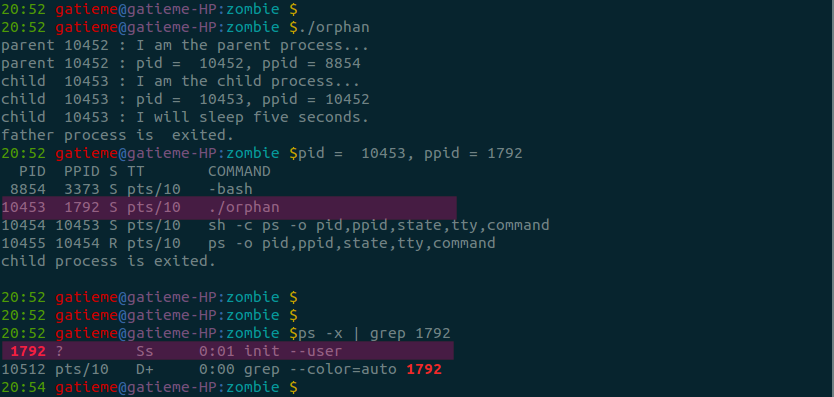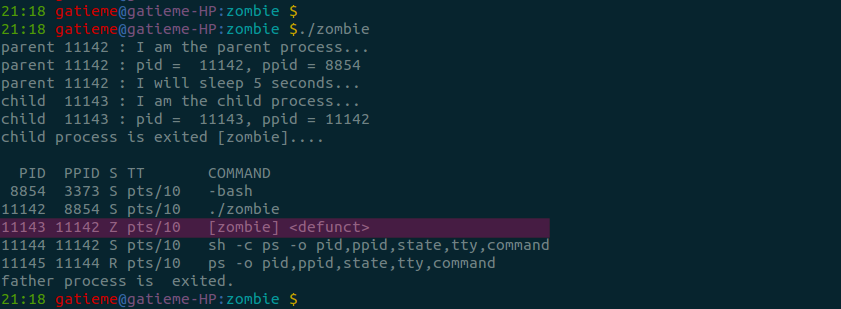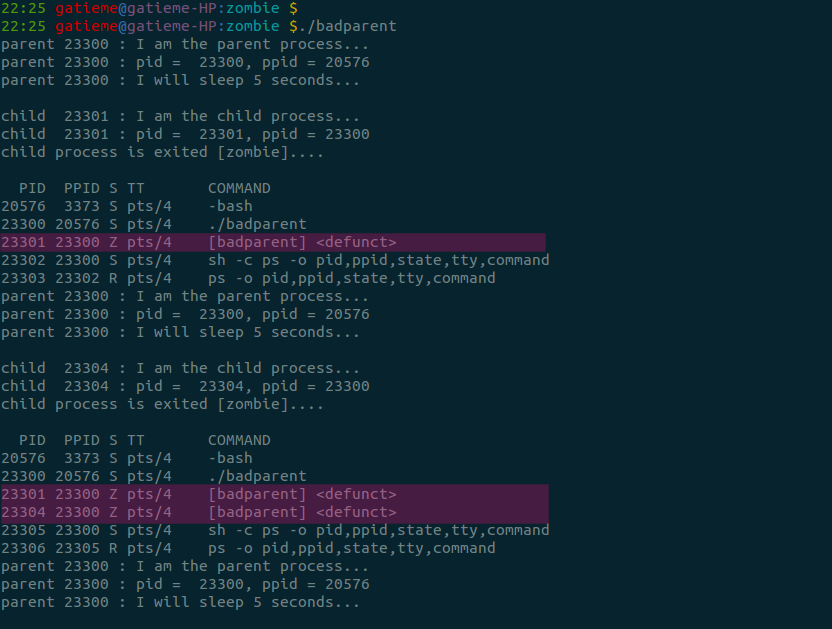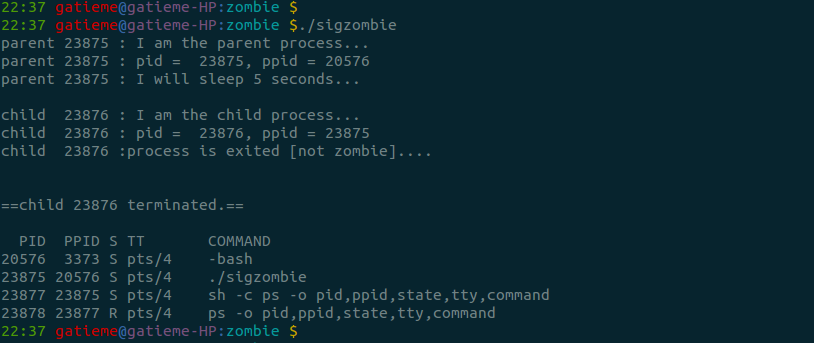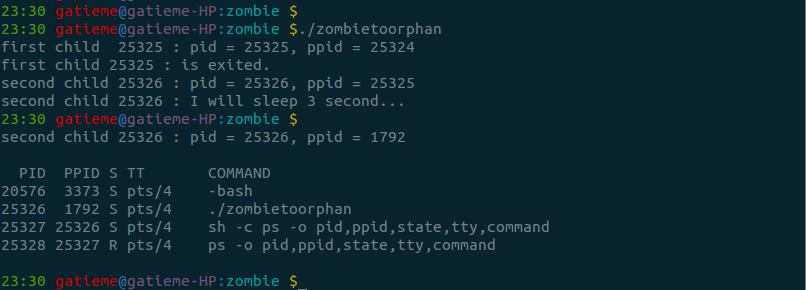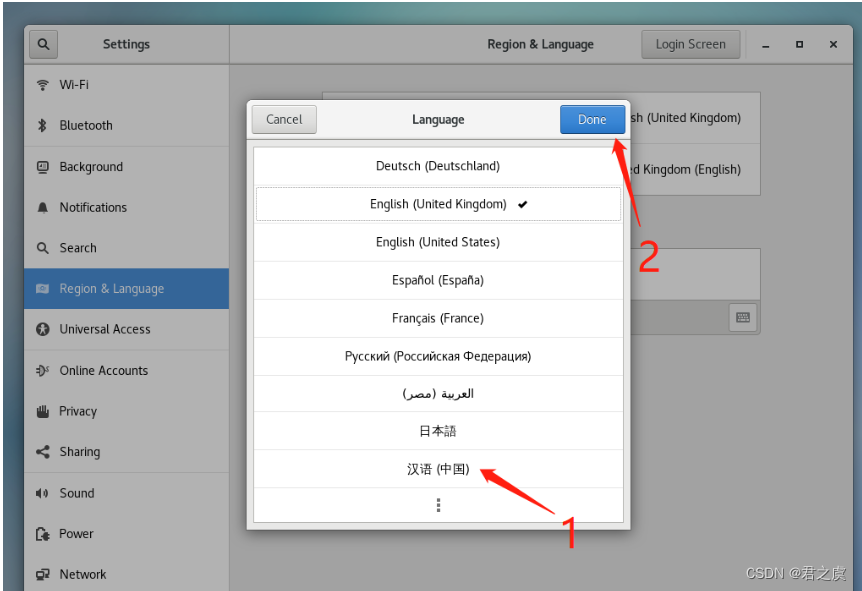代码已上传至https://github.com/gatieme/AderXCoding/tree/master/system/unix/zombie
问题提出
以前在学习《unix环境高级编程》进程时候,提到孤儿进程和僵尸进程,但是一直对这两个概念比较模糊。于是今天做了一些测试程序,并把这些记录下来.
僵尸进程/僵死进程
In UNIX System terminology, a process that has terminated,but whose parent has not yet waited for it, is called a zombie.
在UNIX 系统中,一个进程结束了,但是他的父进程没有等待(调用wait / waitpid)他, 那么他将变成一个僵尸进程。
但是如果该进程的父进程已经先结束了,那么该进程就不会变成僵尸进程, 因为每个进程结束的时候,系统都会扫描当前系统中所运行的所有进程, 看有没有哪个进程是刚刚结束的这个进程的子进程,如果是的话,就由Init 来接管他,成为他的父进程, 这样的进程就是下面的孤儿进程.孤儿进程
相反,如果一个父进程退出,而它的一个或多个子进程还在运行,那么那些子进程将成为孤儿进程。孤儿进程将被init进程(进程号为1或者0)所收养,并由init进程对它们完成状态收集工作。僵尸进程将会导致资源浪费,而孤儿进程不会。
僵尸进程和孤儿进程
我们知道在unix/linux中,正常情况下,子进程是通过父进程创建的,子进程在创建新的进程。子进程的结束和父进程的运行是一个异步过程,即父进程永远无法预测子进程 到底什么时候结束。 当一个 进程完成它的工作终止之后,它的父进程需要调用wait()或者waitpid()系统调用取得子进程的终止状态。
孤儿进程:一个父进程退出,而它的一个或多个子进程还在运行,那么那些子进程将成为孤儿进程。孤儿进程将被init进程(进程号为1)所收养,并由init进程对它们完成状态收集工作。
僵尸进程:一个进程使用fork创建子进程,如果子进程退出,而父进程并没有调用wait或waitpid获取子进程的状态信息,那么子进程的进程描述符仍然保存在系统中。这种进程称之为僵死进程。
问题的产生
由于子进程的结束和父进程的运行是一个异步过程,即父进程永远无法预测子进程到底什么时候结束.
那么会不会因为父进程太忙来不及wait子进程,或者说不知道子进程什么时候结束,而丢失子进程结束时的状态信息呢?
这种机制就是: 在每个进程退出的时候,内核释放该进程所有的资源,包括打开的文件,占用的内存等。但是仍然为其保留一定的信息(包括进程号the process ID,退出状态the termination status of the process,运行时间the amount of CPU time taken by the process等)。直到父进程通过wait / waitpid时才释放.
但这样就导致了问题,我们一般Unix系统中,多进程使用的分叉fork并不保证父子进程的执行顺序(vfork的父进程与子进程是共用地址空间的,子进程会先运行,但是vfork是被废弃掉的调用,BSD里引入它是想避免fork时拷贝父进程的地址空间。所以使用vfork的正常行为是让子进程马上调用exec系列函数。但现在使用写时拷贝,一般不会用vfork了).
由于父子进程运行的顺序是不定的,那么结束的时候也不能确定.因此会出现如下两种情况
①父进程先结束,那么子进程由init进程接管,负责子进程的善后工作,子进程成功孤儿进程.
②子进程先结束,而父进程并没有调用wait或waitpid获取子进程的状态信息,那么子进程的进程描述符仍然保存在系统中,但是成为”黑户”,并不被init所知,更不能被接管,成为僵死进程。
可见如果父进程进程不调用wait / waitpid的话,那么保留的子进程那段信息就不会释放,其进程号就会一直被占用,但是系统所能使用的进程号是有限的,如果大量的产生僵死进程,将因为没有可用的进程号而导致系统不能产生新的进程. 此即为僵尸进程的危害,应当避免。
孤儿进程是没有父进程的进程,孤儿进程这个重任就落到了init进程身上,init进程就好像是一个民政局,专门负责处理孤儿进程的善后工作。每当出现一个孤儿进程的时候,内核就把孤儿进程的父进程设置为init,而init进程会循环地wait()它的已经退出的子进程。这样,当一个孤儿进程凄凉地结束了其生命周期的时候,init进程就会代表党和政府出面处理它的一切善后工作。因此孤儿进程并不会有什么危害。
任何一个子进程(init除外)在exit()之后,并非马上就消失掉,而是留下一个称为僵尸进程(Zombie)的数据结构,等待父进程处理。这是每个子进程在结束时都要经过的阶段。如果子进程在exit()之后,父进程没有来得及处理,这时用ps命令就能看到子进程的状态是“Z”。如果父进程能及时处理,可能用ps命令就来不及看到子进程的僵尸状态,但这并不等于子进程不经过僵尸状态。 如果父进程在子进程结束之前退出,则子进程将由init接管。init将会以父进程的身份对僵尸状态的子进程进行处理。
僵尸进程的危害
例如有个进程,它定期的产 生一个子进程,这个子进程需要做的事情很少,做完它该做的事情之后就退出了,因此这个子进程的生命周期很短,但是,父进程只管生成新的子进程,至于子进程 退出之后的事情,则一概不闻不问,这样,系统运行上一段时间之后,系统中就会存在很多的僵死进程,倘若用ps命令查看的话,就会看到很多状态为Z的进程。 严格地来说,僵死进程并不是问题的根源,罪魁祸首是产生出大量僵死进程的那个父进程。因此,当我们寻求如何消灭系统中大量的僵死进程时,答案就是把产生大量僵死进程的那个元凶枪毙掉(也就是通过kill发送SIGTERM或者SIGKILL信号啦)。枪毙了元凶进程之后,它产生的僵死进程就变成了孤儿进程,这些孤儿进程会被init进程接管,init进程会wait()这些孤儿进程,释放它们占用的系统进程表中的资源,这样,这些已经僵死的孤儿进程 就能瞑目而去了。
示例程序
孤儿进程
/*************************************************************************> File Name: orphan.c> Author: GatieMe> Mail: gatieme@163.com> Created Time: 2015年12月10日 星期四 19时45分16秒************************************************************************/#include <stdio.h>
#include <stdlib.h>
#include <errno.h>
#include <unistd.h>
#include <string.h>#include <sys/types.h>/*** 在这个程序中* 我们先在程序FROK一个子进程* 然后父进程等待1S,* 等待子进程打印出自己的PID, 和父进程的PID* 随后父进程立马退出** 然后子进程在打印出自己和父进程的PID后* 睡眠5S, 以保证父进程先退出* 此时子进程成为孤儿进程, 由init接管* 然后在自己苏醒之后, 再打印出自己的PID和父进程的PID*
**/int main()
{pid_t pid;//创建一个进程pid = fork();if(pid < 0) // FROK创建进程失败时返回-1{printf("fork error errno = %d:%s", errno , strerror(errno));exit(1);}else if(pid == 0) // FROK在子进程中返回0{printf("child %d : I am the child process...\n", getpid( ));// 输出子进程ID和父进程IDprintf("child %d : pid = %d, ppid = %d\n", getpid(), getpid(), getppid());// 睡眠5s,保证父进程先退出printf("child %d : I will sleep five seconds.\n", getpid());sleep(5);printf("pid = %d, ppid = %d\n", getpid(), getppid());//输出进程信息system("ps -o pid,ppid,state,tty,command");printf("child process is exited.\n");//exit(0);}else // FROK在父进程中返回子进程的pid{printf("parent %d : I am the parent process...\n", getpid());printf("parent %d : pid = %d, ppid = %d\n", getpid(), getpid(), getppid());// 父进程睡眠1s,保证子进程输出进程idsleep(1);printf("father process is exited.\n");}return 0;
}
在这个程序中
父进程退出前,父进程pid=10452,子进程pid=10453
父进程退出后,父进程pid=1792,子进程pid=10453
可以由于是在终端中运行,因此我们的init进程并不是主的init进程,而是user的init进程.
这个很容易理解,我们的程序并不是运行在系统的shell中,而是运行在bash中.
如果进入ctrl+alt+F1,进入命令行中,再次运行程序,就可以看到子进程成为孤儿进程后,父进程成为init[pid = 1]
僵尸进程
下面我们修改代码,让子进程直接退出.
/*************************************************************************> File Name: zombie1.c> Author: GatieMe> Mail: gatieme@163.com> Created Time: 2015年12月10日 星期四 19时45分16秒************************************************************************/#include <stdio.h>
#include <stdlib.h>
#include <errno.h>
#include <unistd.h>
#include <string.h>#include <sys/types.h>/*** 在这个程序中* 我们先在程序FROK一个子进程* 然后*
**/int main()
{pid_t pid;//创建一个进程pid = fork();if(pid < 0) // FROK创建进程失败时返回-1{printf("fork error errno = %d:%s", errno , strerror(errno));exit(1);}else if(pid == 0) // FROK在子进程中返回0{printf("child %d : I am the child process...\n", getpid( ));// 输出子进程ID和父进程IDprintf("child %d : pid = %d, ppid = %d\n", getpid(), getpid(), getppid());printf("child process is exited [zombie]....\n");//exit(0);}else // FROK在父进程中返回子进程的pid{printf("parent %d : I am the parent process...\n", getpid());printf("parent %d : pid = %d, ppid = %d\n", getpid(), getpid(), getppid());// 父进程睡眠5s,保证子进程退出printf("parent %d : I will sleep 5 seconds...\n", getpid());sleep(5);system("ps -o pid,ppid,state,tty,command");//printf("father process is exited.\n");}return 0;
}
僵尸进程的危害
下面这个程序中,我们将在父进程中循环产生僵尸进程.
/*************************************************************************> File Name: zombie1.c> Author: GatieMe> Mail: gatieme@163.com> Created Time: 2015年12月10日 星期四 19时45分16秒************************************************************************/#include <stdio.h>
#include <stdlib.h>
#include <errno.h>
#include <unistd.h>
#include <string.h>#include <sys/types.h>/*** 在这个程序中* 父进程每隔5s就将产生一个僵尸进程
**/int main()
{pid_t pid;while( 1 ){//创建一个进程pid = fork();if(pid < 0) // FROK创建进程失败时返回-1{printf("fork error errno = %d:%s", errno , strerror(errno));exit(1);}else if(pid == 0) // FROK在子进程中返回0{printf("child %d : I am the child process...\n", getpid( ));// 输出子进程ID和父进程IDprintf("child %d : pid = %d, ppid = %d\n", getpid(), getpid(), getppid());printf("child process is exited [zombie]....\n\n");// 注意子进程需要退出exit// 要不然会子进程也进入循环疯狂的创建子进程exit(0);}else // FROK在父进程中返回子进程的pid{printf("parent %d : I am the parent process...\n", getpid());printf("parent %d : pid = %d, ppid = %d\n", getpid(), getpid(), getppid());// 父进程睡眠5s,保证子进程退出printf("parent %d : I will sleep 5 seconds...\n\n", getpid());sleep(5);system("ps -o pid,ppid,state,tty,command");printf("father process is exited.\n");}}return 0;
}
解决僵尸进程
/*************************************************************************> File Name: nozombie.c> Author: GatieMe> Mail: gatieme@163.com> Created Time: 2015年12月10日 星期四 19时45分16秒************************************************************************/#include <stdio.h>
#include <stdlib.h>
#include <errno.h>
#include <unistd.h>
#include <string.h>
#include <signal.h>#include <sys/wait.h>
#include <sys/types.h>void signal_child(int signo)
{pid_t pid;int state;//处理僵尸进程while((pid = waitpid(-1, &state, WNOHANG)) > 0){printf("\n==child %d terminated.==\n\n", pid);}return ;
}/*** 在这个程序中* 父进程产生一个僵尸进程* 在子进程退出后, 将信号SIGCHLD* 而父进程中注册了信号SIGCHLD的信号处理函数* 在信号处理函数中, 将使用waitpid子进程
**/
int main()
{pid_t pid;// 注册信号SIGCHLD的处理函数// 当子进程退出时, 此信号将被触发signal(SIGCHLD, signal_child);//创建一个进程pid = fork();if(pid < 0) // FROK创建进程失败时返回-1{printf("fork error errno = %d:%s", errno , strerror(errno));exit(1);}else if(pid == 0) // FROK在子进程中返回0{printf("child %d : I am the child process...\n", getpid( ));// 输出子进程ID和父进程IDprintf("child %d : pid = %d, ppid = %d\n", getpid(), getpid(), getppid());printf("child %d :process is exited [not zombie]....\n\n", getpid());// 注意子进程需要退出exit// 要不然会子进程也进入循环疯狂的创建子进程exit(0);}else // FROK在父进程中返回子进程的pid{printf("parent %d : I am the parent process...\n", getpid());printf("parent %d : pid = %d, ppid = %d\n", getpid(), getpid(), getppid());// 父进程睡眠5s,保证子进程退出printf("parent %d : I will sleep 5 seconds...\n\n", getpid());sleep(5);system("ps -o pid,ppid,state,tty,command");}return 0;
}
子进程成为孤儿进程–fork两次
《Unix 环境高级编程》中非常详细。原理是将子进程成为孤儿进程,从而其的父进程变为init进程,通过init进程可以处理僵尸进程
在这个方法中,我们第一次创建的进程只是一个过渡进程,它在创建了第二个进程后就立即消亡,从而使第二个进程成为一个孤儿进程,由init接管.
而我们通过让原进程wait第一个进程来保证第一个进程不会成为僵死进程
由于第一个进程没做任何操作,便立即退出,因此源进程wait第一个进程的花销几乎可以不计.因此如果一个进程要fork一个子进程,但不要求它等待子进程终止,也不希望子进程处于僵死状态直到父进程终止,可以使用这种方法.
在这种方法中,父进程和第二个子进程才是真正工作的进程,而第一个子进程只是用于fork第二个子进程的一个过渡进程,通过它使父进程和第二个子进程的不存在直接的父子关系,从而避免了僵死进程的产生.
/*************************************************************************> File Name: zombietoorphan.c> Author: GatieMe> Mail: gatieme@163.com> Created Time: 2015年12月10日 星期四 22时49分02秒************************************************************************/#include <stdio.h>
#include <stdlib.h>
#include <unistd.h>
#include <errno.h>#include <sys/types.h>
#include <sys/wait.h>/*** 如果一个进程要frok一个子进程,但不要求它等待* 子进程终止,也不希望子进程处于僵死状态直到父进程终止,* 实现这一要求的诀窍是调用fork两次**/
int main()
{pid_t pid;if((pid = fork( )) < 0) // 父进程中创建子进程{perror("fork error:");exit(-1);}else if(pid == 0) // 第一个子进程中{printf("first child %d : pid = %d, ppid = %d\n",getpid( ), getpid( ),getppid( ));/*** 在子进程中* 我们再次fork产生第二个子进程* 然后第二个子进程在等待其父进程(第一个子进程)退出后再退出* 这样第二个子进程成为孤儿进程, 由init接管它**/if((pid = fork( )) < 0) // 子进程中再创建子进程{perror("fork error:");exit(-1);}else if(pid > 0) // 第一个子进程直接退出{printf("first child %d : is exited.\n", getpid( ));exit(0);}else // 第二子进程在其父进程第一个子进程退出后再退出{printf("second child %d : pid = %d, ppid = %d\n", getpid( ), getpid( ), getppid( ));printf("second child %d : I will sleep 3 second...\n", getpid());// 睡眠3s保证第一个子进程退出,这样第二个子进程的父亲就是init进程里sleep(3);//// 第二个进程才是我们真正创建出来期望工作的进程//printf("\nsecond child %d : pid = %d, ppid = %d\n\n", getpid( ), getpid( ), getppid( ));system("ps -o pid,ppid,state,tty,command");exit(0);}}//父进程处理第一个子进程退出if (waitpid(pid, NULL, 0) != pid){perror("waitepid error:");exit(1);}exit(0);return 0;
}